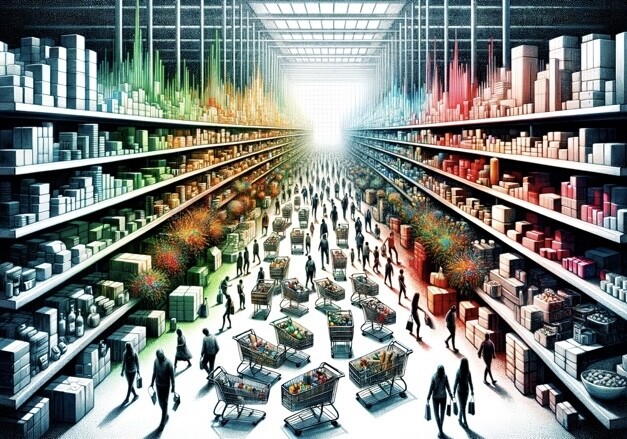Credit Card Spending Slowdown: A Challenging Outlook For Issuers

Table of Contents
Macroeconomic Factors Fueling the Credit Card Spending Slowdown
Several significant macroeconomic factors are converging to fuel the credit card spending slowdown, creating a perfect storm for issuers.
Inflation and Rising Interest Rates
Inflation is relentlessly eroding purchasing power. Simultaneously, increased interest rates implemented by central banks to combat inflation are leading to higher borrowing costs. This double whammy significantly reduces consumer spending.
- Increased Costs: Everyday expenses like gas, groceries, and housing are soaring, leaving consumers with less disposable income.
- Impact on Disposable Income: The squeeze on household budgets is forcing consumers to prioritize essential spending, leaving less room for discretionary purchases made with credit cards.
- Increased Interest on Existing Debt: Higher interest rates increase the cost of servicing existing credit card debt, further limiting available funds for new spending.
Recessionary Fears and Consumer Sentiment
Negative economic forecasts and declining consumer confidence are further dampening spending habits. Fear of job losses and economic uncertainty are prompting consumers to adopt a more cautious approach to their finances.
- Consumer Confidence Indices: Major consumer confidence indices are showing a consistent downward trend, reflecting growing pessimism among consumers.
- Impact on Discretionary Spending: Consumers are cutting back on non-essential purchases, directly impacting credit card transaction volumes.
- Increased Savings Rates: Many are prioritizing saving money as a precautionary measure against potential economic hardship.
Geopolitical Uncertainty
Global events, such as the ongoing war in Ukraine and persistent supply chain disruptions, contribute to economic instability and uncertainty, impacting consumer behavior.
- Geopolitical Impacts: The war in Ukraine has driven up energy prices and disrupted global supply chains, leading to increased inflation and reduced consumer confidence.
- Effect on Credit Card Spending: This uncertainty causes consumers to delay major purchases and reduce overall spending, impacting credit card usage significantly.
Shifting Consumer Behavior and Spending Preferences
Beyond macroeconomic factors, shifts in consumer behavior and spending preferences are also contributing to the credit card spending slowdown.
Increased Debt Levels and Debt Consolidation
Rising household debt levels are forcing consumers to prioritize debt consolidation and repayment strategies, reducing their reliance on credit cards for new purchases.
- Household Debt Statistics: Data shows a steady increase in overall household debt, leaving many consumers with less financial breathing room.
- Balance Transfer Cards: The increased popularity of balance transfer cards, which offer lower interest rates for a limited time, demonstrates consumers' focus on managing existing debt.
- Impact on Credit Card Spending Growth: This focus on debt reduction directly translates to slower growth in credit card spending.
Rise of Alternative Payment Methods
The emergence and growing popularity of Buy Now, Pay Later (BNPL) services and digital wallets are diverting transactions away from traditional credit cards.
- Market Share of BNPL and Digital Wallets: BNPL services and digital payment platforms are rapidly gaining market share, offering attractive alternatives to credit cards.
- Reasons for Increasing Popularity: These services often offer flexible payment options and seamless integration into online shopping platforms.
- Implications for Credit Card Issuers: The shift towards alternative payment methods presents a significant challenge to credit card issuers, threatening their market dominance.
Increased Focus on Saving and Debt Reduction
A notable shift in consumer priorities is evident: saving money and paying down existing debt are taking precedence over incurring new debt.
- Data on Savings Rates: Savings rates have increased in recent periods, indicating a greater focus on financial security among consumers.
- Consumer Attitudes Towards Debt: Consumers are increasingly adopting a more cautious approach to debt, prioritizing repayment over new borrowing.
- Impact on Credit Card Application Rates: This shift is reflected in lower credit card application rates as consumers prioritize debt reduction.
Strategies for Credit Card Issuers to Navigate the Slowdown
Credit card issuers must adapt to the changing environment to mitigate the impact of the credit card spending slowdown.
Adjusting Marketing and Rewards Programs
Issuers need to refine their marketing strategies and rewards programs to attract and retain customers in a more competitive and price-sensitive market.
- Adjusted Rewards Programs: Offering more relevant and competitive rewards programs can incentivize spending and loyalty.
- Targeted Marketing Campaigns: Tailoring marketing messages to specific demographics and their financial priorities is crucial.
- Adapting Credit Limits and Interest Rates: Strategically adjusting credit limits and interest rates can attract and retain customers while managing risk.
Diversifying Revenue Streams
Relying solely on traditional credit card interest and fees is no longer a sustainable strategy. Issuers need to explore new avenues for revenue generation.
- Additional Financial Products: Offering ancillary financial products such as personal loans or insurance can diversify revenue streams.
- Partnerships with Merchants: Collaborating with merchants to offer exclusive discounts or promotions can drive card usage.
Enhancing Customer Service and Retention
Prioritizing excellent customer service and strengthening customer relationships is paramount in retaining existing customers and building loyalty.
- Improved Customer Support: Providing prompt and efficient customer support builds trust and enhances customer satisfaction.
- Personalized Financial Management Tools: Offering personalized financial management tools can help customers manage their finances effectively.
- Proactive Communication: Proactive communication with customers, offering support and relevant financial advice, fosters stronger relationships.
Conclusion: Addressing the Credit Card Spending Slowdown – A Call to Action for Issuers
The credit card spending slowdown is driven by a combination of macroeconomic headwinds, shifting consumer behavior, and increased competition. These challenges necessitate proactive strategies from credit card issuers. Failure to adapt could lead to decreased profitability and market share. Issuers must analyze emerging credit card spending trends, understand the evolving needs of consumers, and implement innovative strategies to mitigate the impact of the slowdown in credit card usage and ensure long-term sustainability. This requires a comprehensive review of business models, a focus on customer retention, and an exploration of new revenue streams to navigate these credit card industry challenges effectively. The future success of credit card issuers hinges on their ability to respond effectively to this evolving landscape.

Featured Posts
-
 Palisades Fire Aftermath Celebrities Home Losses Revealed
Apr 24, 2025
Palisades Fire Aftermath Celebrities Home Losses Revealed
Apr 24, 2025 -
 Oblivion Remastered Official Release Date And Details
Apr 24, 2025
Oblivion Remastered Official Release Date And Details
Apr 24, 2025 -
 The Bold And The Beautiful Thursday April 3 2024 Liams Collapse And Hopes New Home
Apr 24, 2025
The Bold And The Beautiful Thursday April 3 2024 Liams Collapse And Hopes New Home
Apr 24, 2025 -
 Watch John Travolta Savor A Pulp Fiction Steak In Miami
Apr 24, 2025
Watch John Travolta Savor A Pulp Fiction Steak In Miami
Apr 24, 2025 -
 The Unexpected Business Strategy How One Airline Leverages Deportation Flights
Apr 24, 2025
The Unexpected Business Strategy How One Airline Leverages Deportation Flights
Apr 24, 2025
